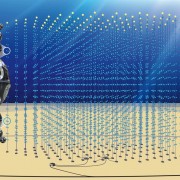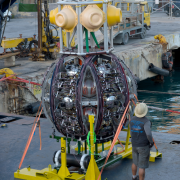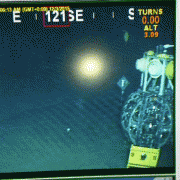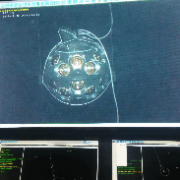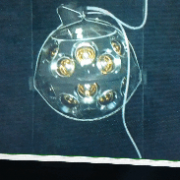8 December 2015: In the early morning of 3 December 2015, scientists and engineers started the installation of KM3NeT, which once completed, will be largest detector of neutrinos in the Northern Hemisphere. Located in the depths of the Mediterranean Sea, the infrastructure will be used to study the fundamental properties of neutrinos and map the high-energy cosmic neutrinos emanating from extreme cataclysmic events in the Universe.
Neutrinos are the most elusive of elementary particles and their detection requires the instrumentation of enormous volumes: the KM3NeT neutrino telescope will occupy more than a cubic kilometre of seawater. It comprises a network of several hundred vertical detection strings, anchored to the seabed and kept taut by a submerged buoy. Each string hosts 18 light sensor modules equally spaced along its length. In the darkness of the abyss, the sensor modules register the faint flashes of Cherenkov light that signal the interaction of neutrinos with the seawater surrounding the telescope.
On board the Ambrosius Tide deployment boat, the first string – wound, like a ball of wool, around a spherical frame – arrived at the location of the KM3NeT-Italy site south of Sicily. It was anchored to the seabed at a depth of 3500 m and connected to a junction box, already present on the seafloor, using a remotely operated submersible controlled from the boat. The junction box is connected by a 100 km cable to the shore station located in Portopalo di Capo Passero in the south of Sicily.
Marco Circella, the technical coordinator of KM3NeT explains, “The large depth of sea water shields the telescope from particles created by cosmic rays in the atmosphere above the telescope. Constructing such a large infrastructure at these depths is a tremendous technical challenge. Making the underwater connections requires custom-designed electrical and fibre optic connectors. The crew of the Ambrosius Tide are experts in performing such delicate submarine operations.”
After verification of the quality of the power and fibre optic connections to the shore station, the go ahead was given to trigger the unfurling of the string to its full 700 m height. During this process, the deployment frame is released from its anchor and floats towards the surface while slowly rotating. In doing so, the string unwinds from the spherical frame, eventually leaving behind a vertical string. The string was then powered on from the shore station and the first data from the sensor modules started streaming to shore.
Rosanna Cocimano who coordinates the power systems for KM3NeT: “An electro-optical network of cables distributes the high-voltage power from the shore station to the sensor modules in the deep sea. The measured light signals are digitised by the sensor modules and the resulting data returned to the shore station via optical fibres.”
The successful acquisition of data from the abyss with the novel technology developed by the KM3NeT Collaboration is a major milestone for the project. It represents the culmination of more than ten years of research and development by the many research institutes comprising the international Collaboration.
Maarten de Jong, spokesperson and director of KM3NeT, said: “This important step in the verification of the design and the technology will allow the KM3NeT Collaboration to proceed with confidence toward the mass production of detection strings and their installation at the sites in the Mediterranean Sea off-shore from Italy and France. A new era in neutrino astronomy has begun”.
Press release: pdf
Images:
A building block of KM3NeT comprises 115 detections strings; the full detector has many building blocks with a total of a few hundred strings (courtesy Marc de Boer/Ori Ginale)
The neutrino detection string wound around the spherical deployment frame prior to deployment.
Touch down of the deployment frame on the sea floor (photo of the display screens in control room).
Two of the sensor modules after the unfurling- images taken by the camera of the submersible (photo of the display screens in control room).

